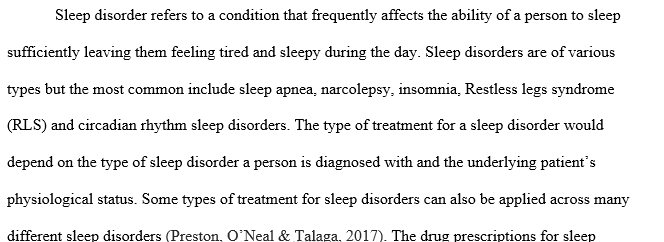Sleep disorders
Treatment of Sleep Disorders
In a 4 page, APA-formatted paper, include the following:
A description and explanation of the major types of drugs prescribed for sleep disorders
An explanation of the potential for addiction associated with these medicines
An explanation of the issues related to malingering in the treatment of sleep disorders
An explanation of the mental health professional’s role in mitigating the potentialities of malingering
According to the National Sleep Foundation (2013), about 30–40% of the general population reports some level of insomnia during their lives, and 10–15% experience significant, chronic insomnia. For these individuals, medications to help induce and sustain sleep may be helpful. On the other hand, sleep aids pose potential concerns, namely abuse. Some people exceed recommended doses, and some continue taking medications even after symptoms are no longer present. Others obtain medications under false pretenses, which is one form of malingering. Malingering occurs when clients make up or exaggerate symptoms for some personal gain. Although mental health professionals may not be directly implicated in the client’s deceit, their unique position to receive more accurate and honest information than other medical professionals presents ethical concerns. What is the mental health professional’s role in these instances? In which instances would it be appropriate to break confidentiality due to a concern of malingering? How could the malingering potentiality be planned for and avoided?
For this Assignment, conduct an scholarly and Internet search for at least two peer-reviewed journal article that addresses a counseling issue related to malingering and addiction in treating sleep disorders.
Required learning resources for the assignment
Lichtblau, L. (2011). Psychopharmacology demystified. Clifton Park, NY: Delmar, Cengage Learning.
Chapter 6, “Anxiolytic-Sedative-Hypnotic Drug Pharmacotherapy” (previously read in Week 5)
Preston, J. D., O’Neal, J. H., & Talaga, M. C. (2017). Handbook of clinical psychopharmacology for therapists (8th ed.). Oakland, CA: New Harbinger.
Chapter 15, “Other Miscellaneous Disorders” (pp. 161-174)
Link to access book https://books.google.com/books?id=f57QOh7XIYoC&printsec=frontcover&dq=Preston,+J.+D.,+O%E2%80%99Neal,+J.+H.,+%26+Talaga,+M.+C.+(2017).+Handbook+of+clinical+psychopharmacology+for+therapists+(8th+ed.).+Oakland,+CA:+New+Harbinger.&hl=en&sa=X&ved=0ahUKEwibiPza3MThAhXPzlkKHXY3CMwQ6AEIQjAE#v=onepage&q&f=false
National Institute of Neurological Disorders and Stroke. (2014). Brain basics: Understanding sleep. Retrieved from http://www.ninds.nih.gov/disorders/brain_basics/un…
Link: https://www.ninds.nih.gov/Disorders/Patient-Caregiver-Education/Understanding-Sleep#sleep_disorders
Answer preview to sleep disorders
APA
1293 words


